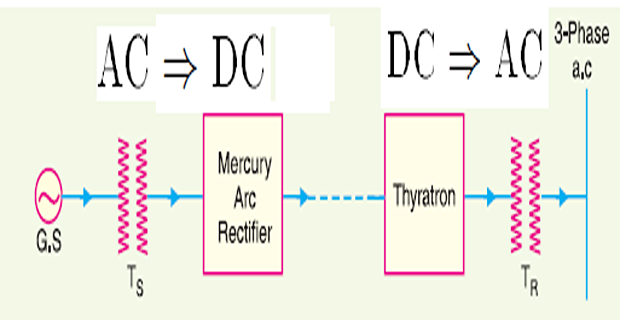Demonstrative Video
Lecture-5: Overview
Comparison of D.C. & A.C. Transmission
Advantages & Limitations of High Transmission Voltages
Electric Power Transmission
Electric power can be transmitted by means of d.c. or a.c.
Each system has its own merits & demerits.
Desirable to discuss the technical advantages & disadvantages of the two systems for transmission of electric power
Advantages of D.C. Transmission
Two conductors as compared to three for a.c.
No \(L,C,\phi\) and surge problems
\(L\) absence, Vdrop, dc < Vdrop, ac for same load & \(V_s\)
For this reason, a d.c. line has better voltage regulation.
No skin effect entire cross-section of the line conductor is utilised.
For the same working voltage, Vstress, dc < Vstress, ac, requires less insulation.
Less corona loss & reduced interference with communication circuits
HVDC transmission is free from dielectric losses, particularly in the case of cables.
No stability problems and synchronising difficulties
Disadvantages of D.C. Transmission
Electric power cannot be generated at high d.c. voltage due to commutation problems.
The d.c. voltage cannot be stepped up for transmission of power at high voltages.
The d.c. switches and circuit breakers have their own limitations.
Advantages of A.C. Transmission
Now-a-days, electrical energy is almost exclusively generated, transmitted and distributed in the form of a.c.
Power can be generated at high voltages.
The maintenance of a.c. sub-stations is easy and cheaper.
The a.c. voltage can be stepped up or stepped down by transformers with ease and efficiency.
This permits to transmit power at high voltages and distribute it at safe potentials.
Disadvantages of A.C. Transmission
An a.c. line requires more copper than a d.c. line.
Construction of a.c. line is more complicated than a d.c. transmission line.
Due to skin effect in the a.c. system, the effective resistance of the line is increased.
Due to capacitance in a.c line there is a continuous loss of power due to charging current even when the line is open.
Conclusion
HV d.c. transmission is superior than a.c. counterpart
At present a.c transmission is used but there is an increasing interest in d.c. transmission.
Introduction of mercury arc rectifiers & thyratrons have made possible a.c. \(\Leftrightarrow\) d.c. easily & efficiently.
Devices operate upto 30 MW/ 400 kV/single units.
Present day trend is towards a.c. for G & D and high voltage d.c. for transmission.

Advantages of High Transmission Voltages
Reduces volume of conductor material:
Load current, \(I=\frac{P}{\sqrt{3} V \cos \phi}\)
Resistance/conductor, \(R=\rho l / a\)
Total power loss, \(W=3 I^{2} R =\frac{P^{2} \rho l}{V^{2} \cos ^{2} \phi a}\)
Area of \(\mathrm{X}\) -section, \(a=\frac{P^{2} \rho l}{W V^{2} \cos ^{2} \phi}\)
- \[=3 a l=3\left(\frac{P^{2} \rho l}{W V^{2} \cos ^{2} \phi}\right) l =\frac{3 P^{2} \rho l^{2}}{W V^{2} \cos ^{2} \phi}\]Total volume of conductor material required
Increases Transmission Efficiency:
Decreases percentage line drop:
Limitations of High Transmission Voltage
the increased cost of insulating the conductors
the increased cost of transformers, switchgear and other terminal apparatus
Therefore, there is a limit to the higher transmission voltage which can be economically employed
This limit is reached when the saving in cost of conductor material due to higher voltage is offset by the increased cost of insulation, transformer, switchgear etc.
Hence, proper choice of transmission voltage is essentially a question of economics